#handscroll painting
Text

Autumn Colors along Rivers and Mountains 江山秋色圖
Handscroll. Ink and color on silk.
Height: 55,6 cm. Length: 232,2 cm.
Southern Song Dynasty (1127 AD –1279 AD)
This painting is attributed to Zhao Boju 趙伯駒 (born 1120-1130 AD; died 1162 AD). In order to better appreciate this masterpiece, one shall start by looking at the right edge of the painting ("the start") and slowly "travel" towards the left edge ("the end"). At first glance it might seem like there are no other elements other than the natural landscape, but watching closely, one can see that the artist did an extremely meticulous work: there are buildings perched between the mighty mountains, groups of people walking, and even a caravan towards the end of the scroll.
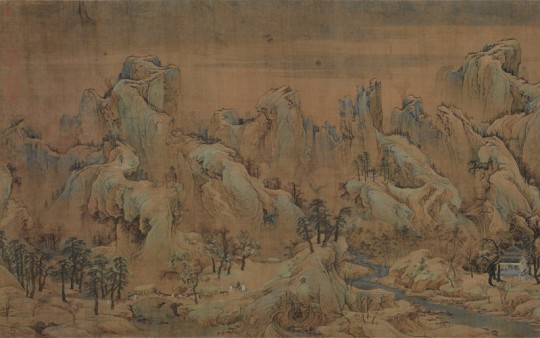
The painting is at present located in the Palace Museum of Beijing ( Gugong 故宫) and can be viewed at this link.
0 notes
Text
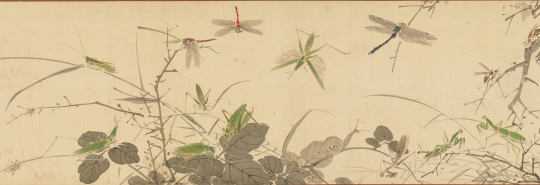
Insects and Grasses, Yamamoto Baiitsu, 1847
#art#art history#Asian art#Japan#Japanese art#East Asia#East Asian art#Yamamoto Baiitsu#genre painting#insects and grasses#scroll#handscroll#ink and color on silk#Edo period#19th century art#Metropolitan Museum of Art
201 notes
·
View notes
Photo

Chai Zhenyi 柴貞儀 and Chai Jingyi 柴靜儀, Flowers and Insects, circa 17th century (Qing Dynasty, reign of Kangxi, 1662-1722)
#Chai Zhenyi#Chai Jingyi#art#womens art#chinese art#Women Artists#painting#17th century art#handscroll#ink#art history#nature#chinese history
17 notes
·
View notes
Photo
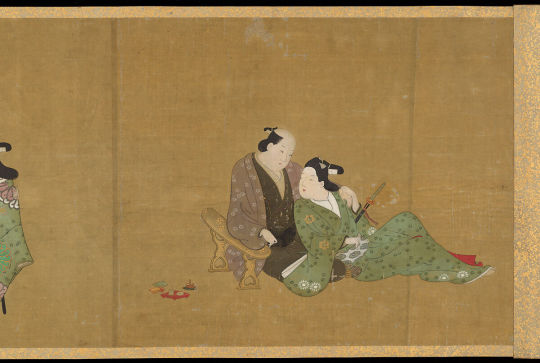



Portion of a Handscroll of Ten Homoerotic (Nanshoku) Scenes, Miyagawa Choshun, Early 18th Century
#hand scroll of ten homoerotic (nanshoku) scenes#miyagawa choshun#choshun miyagawa#early 18th century#18th century#1700s#painting#scroll#handscroll#art
7 notes
·
View notes
Video
Formats of Chinese Paintings.https://quanronggallery.com/
26 notes
·
View notes
Text

Xie Chufang, Fascination of Nature, a handscroll painting
0 notes
Text

Insects and Grasses
dated 1847
source
#found by kino#Scroll paintings#Paintings#Handscrolls#Handscroll#ink and color on silk#Metropolitan Museum of Art#Asia#dated 1847#Ink#Japan#Silk#edo period
1 note
·
View note
Text

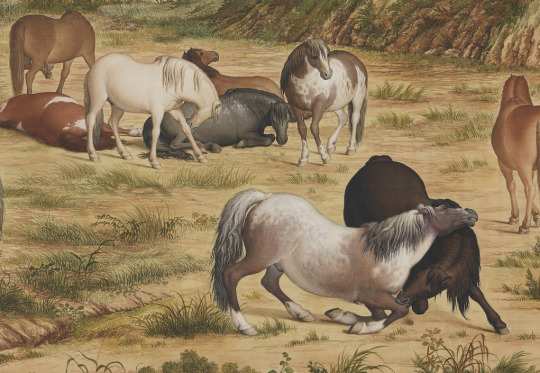
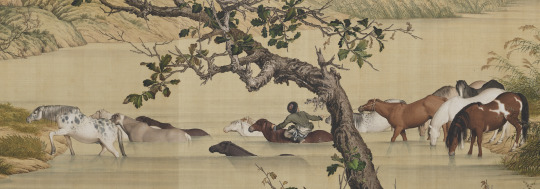

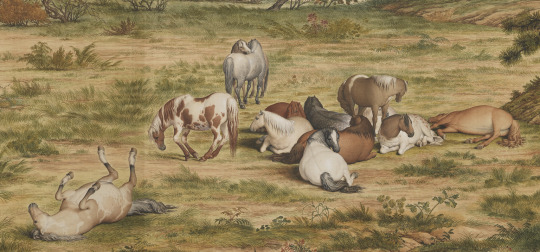
Some of my favorite details from One Hundred Horses (1728) by Giuseppe Castiglione, a tempera painting on a 776 cm (nearly 25 ft) silk handscroll from the Qing dynasty. It's very worth viewing it in full for yourself.
150 notes
·
View notes
Text

Qian Xuan, Young nobleman on horseback, a handscroll painting Yuan dynasty, 27th year of Zhiyuan (1290), China
#Qian Xuan#chinese artist#chinese painting#chinese painter#chinese art#asian art#horses#beautiful horse#beautiful animals#horseback riding#equestrian#aesthetic#beauty#scroll painting#art history#aesthetictumblr#tumblraesthetic#tumblrpic#tumblrpictures#tumblr art#tumblrstyle#artists on tumblr
38 notes
·
View notes
Text
Take the bitter with the sweet
Writing this was hard but it helped me realize that I can still call myself a writer even though I don’t post as much as I want to. I do hope that you liked it, @cottonfluffballofdoom, and let’s create even more beautiful works together during future @flash-exchange.
Thank you so much for having me here. Without you all I can't call this place home 💛
Character: Hideyoshi
Promt: Something sweet, something bitter

“...and if one day faith brings us a new challenge, I want to meet it by your side. For as you see, we are the warriors, my dear, and at war as at war. We may be losing our battles here, but we will never be defeated for being loved.
Find me. Quick, I’ll wait.”
Autumn has finally blossomed, turning the city’s gardens into one rustling sea of scarlet poppies, amber gold and ochreous ground. Maple leaves are everywhere.
You enter the cool emptiness of a local gallery hall. A maple leaf is gracefully falling at your feet. Nothing is going to be the same, but maybe tomorrow a tiny bud will appear where now emptiness is present.
Memories of the past still hurt like a scar that has barely healed. It is painful. Not because you have it, but because it will never disappear. A year has passed since your life was divided into before and after. A year since the man who promised to live for the sake of your breath on his lips pushed you into the black hole of despair, separating himself from the course of your life.
____________
“Everything is fine,” the trembling sound of your voice was a strange contrast to a bright smile on your face, “we’re gonna make it together. It is so much easier with you by my side.”
That was not true, and you both knew that. The following silence condemned your lies, as does the quiet crowd when a singer hits the wrong note.
“This can’t continue. You are struggling because of me.” Through a transparent surface of a folding screen you could see his mourning profile with shoulders painfully stretched. Wheaten hair was for the first time touched with silver.
“I need to do the right thing. This is my duty to protect you, after all.”
____________
Yes, it was right. Your body and mind were becoming weaker with each day, and so his grip of your hand was getting tighter. Your lover’s embrace sank like ink into your essence, forever changing its structure, so when you returned to “the present” it was hard to find your own reflection in the mirror. For how can one see the whole when a half is missing?
Yet, life still goes on. The leaves are falling to give new buds a chance to bloom and blossom into something beautiful. You too have to keep going. Even if it means stepping on the broken glass.
The gallery hall is all but dark shadows coming when the icy sunlight is no longer falling from the roof, hidden with November clouds. Myriads of scroll paintings on the walls are telling you about distant times when one country was divided into many. People were suffering, and whispers of poets, mourning for their motherland, were mixing with cries of mothers who’d lost their children. Still, even in the times of darkness there was a place for light.
One handscroll is dedicated to a story of a man who sought happiness in death until he found a woman who made him fall in love with life.
You look at another painting with little monkeys reaching for the reflection of the moon instead of searching for it in the sky.
“Silly monkey,” a sudden rush of air gives you goosebumps, “always being so stubborn, never listening to others. I’ll never forgive you.”
“Then don’t. Let the monkey learn its lesson.”
Somebody drops a silk coat on your shoulder, and it smells like almond, tea and parchment. Or maybe you just imagine everything. The scent of home, Azuchi, where you used to sew another kimono for your lover on engawa under the night stars. Dim candles left the aroma of incense on your fingers, and you asked the moon to give you some more light.
Almond, tea and parchment. That’s how your pillows smelt after a night of passion. Sometimes you could feel a light touch of his fingers caressing your hair, warm breath on collarbones.
“Let's work hard today. Don’t forget to eat your breakfast. It’s on the table.”
Almond, tea and parchment. So sweet that it was almost bitter. That’s how your last goodbye felt. Stars dropping from the sky.
“Find me. Quick, I’ll wait.”
You turn around.

(a letter found in your clothes after returning to modern Japan)
Tonight you coughed. Again. I held you in my arms till the first rays of sun appeared on the horizon, but it could barely help you, my dear wife. You fell asleep when I left the room only to lean against the wall and listen to the quiet sound of your breath.
Every single day you fight with darkness that is way stronger than you, yet your smile keeps getting wider after each battle, and my love for you is growing stronger.
Sasuke thinks that your condition may become worse as the wormhole is getting closer. That your body and mind may leave me forever. And so I recall.
I recall the memories of your funny face when the morning sun plays with your hair. I think of our conversations, when nature is quiet in the evening and the wind is full of scents. You tell me about Mitsunari’s cat, about your daily tasks and bickering with Mitsuhide. You look so peaceful that it feels surreal. I want to hug you tight and become something bigger than I am now. To protect, to love, to honor your brave yet tender soul.
You are the force of nature. A sun-dazzling creature, you came into my life to create havoc, and now you may disappear, my beautiful thunder.
We argue. Again. You say I’m too stubborn. You blame me for not allowing you to decide for yourself. You think you can handle it. A silly liar.
But listen..
I know how it feels to be alone. I thought I found the meaning in serving lord Nobunaga. And I still do think so. But now I can't say I don’t have anything to lose. I have. And it's you.
I want to fight for your future, I want you to see the life you've taught me to love. And so I want you to leave.
To become the person you want to be. To share your strength with others. To be full. Don’t forget to eat. Don’t exhaust yourself. And try to find me. I promise to do the same.
I know you’ll probably hate me for what I’m going to do. For forcing you to go back to your time. But I would rather have you alive but distant than ill by my side.
If one day faith brings us a new challenge, I want to meet it by your side. For as you see, we are the warriors, my dear, and at war as at war. We may be losing our battles here, but we will never be defeated for being loved.
Forever yours,
Hideyoshi
17 notes
·
View notes
Text

Maruyama Ōkyo (1733 – 1795), ink and color sketches on two handscrolls (1771-72) CHISO CO., LTD.
Maruyama Okyo (1733-1795) was a pioneer of bringing together Chinese and other East Asian techniques with the realism of Western naturalism within his Japanese-style painting. Though neither a simple reflection of realism nor naturalistic sketching, Okyo's work was originally criticized for being overly concerned with realistic portrayals, despite being received well by the general public. Recently, his work has been gaining more recognition as scholars and admirers appreciate the complicated technical skills behind each of his pieces. (https://www.japantimes.co.jp/)
35 notes
·
View notes
Text

Clouds over the River before Rain, Shen Zhou (1427-1509)
#art#art history#Asian art#China#Chinese art#East Asia#East Asian art#Imperial China#Ming Dynasty#Shen Zhou#Wu School#landscape#landscape painting#handscroll#ink and color on paper#15th century art#Art Institute of Chicago
143 notes
·
View notes
Text
Lecture Notes MON 29th JAN
Masterlist
BUY ME A COFFEE
The Artwork in History: 'Beyond' Europe

Giving general History as background becomes not applicable due to the world being so large and so much happening. Not only that, but historical and cultural contexts begin to fall apart due to our lecturer not specialising/lecturers knowing certain places etc. A trend in Art History is that the country in which you study it, is usually the country that specialises in it. Even in Europe, despite Art History being considered Eurocentric.
Which it sort of is, but even so, it focuses on Britian (England), France, and Italy. Perhaps momentarily Spain, but very rarely. And when foreign language classes are offered alongside Art History studies, they will still focus on these countries, maybe Germany is added but very rarely.
This is slowly being tackled within universities, especially the ones in London that I had applied for and discussed attending with. But still the European dominance and favouritism is obvious, perhaps mainly due to the fact that to do cultural and contextual reading you need to know the language/should as it shapes the understanding of the artwork a lot.
Our lecturer admitted to realising that he was very much uneducated on the rest of the world, admitting his ignorance, he had decided to educate us and show us how he attempted to tackle this. As he dubbed it, his “revelation of ignorance”, with this blog while I do focus on what I’m learning in class, I try to reach out and also cover other art in Europe and across the world. Albeit I am a student learning alongside everyone else, and everyone who discovers this blog.
Here is the reading list given by Oxford covering Art History, I’ve highlighted all the Eurocentric/Western books: and as you can see, there is very little variety.
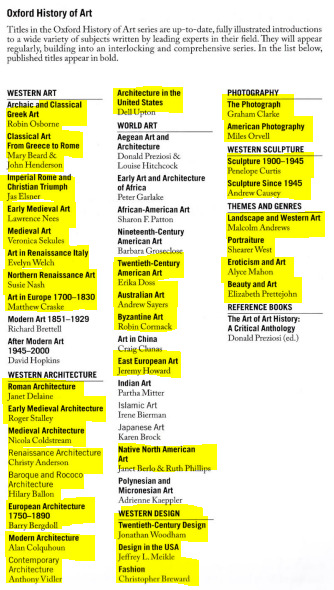
I recommend reading Craig Clunas books if you’re interested in Chinese Art and Art History in China as he is an incredible Art Historian and very well versed. Speaking of Chinese art, I present a Ming Dynasty scroll:
youtube
This YouTube video does an incredible job of displaying the whole scroll, rather than cutting it up like in photos.

Xia Chang (1388-1470), Bamboo-Covered Stream in Spring Rain, 1441, handscroll, ink on paper, 41.3 x 1500 cm, Art Institute of Chicago
This scroll was made around the same time as the Renaissance was beginning/happening in Florence, it’s a very contemplative view of nature and draws on calligraphy. While it does not display as much detail, that is to not say that it doesn’t evoke emotion and stir the viewer. Originally this was a private gift exchange, which at the time in China was a common occurrence.
Zhou Jihong of Haiwu built a house at Xichou, where ten thousand long bamboo trees surround the stream. I love the quiet and beautiful scenery of stream and rocks, and the green and moist color of bamboo is enough to clean away worldly worries. One day Jihong had his second son, Tingyue, bring me a roll of blank paper and ask for a painting of bamboo. At that time, I was enjoying the coolness at the Pine Pavilion; therefore, I thought about the scenery and painted the Bamboo-Bordered Stream in Spring Rain. Although my painting cannot match the old masters’ essence of learning, it resembles the scenery of Xichou. I wonder if Jihong, who is a scholar of profound knowledge, has the same feeling when he looks at this painting. On the first day of the sixth month, in the xinyou year of the Zhentong reign [1441], Xia Chang Zhongshao of Dongwu.
We are very used to seeing old maps of the world, from the Eurocentric perspective, but what about maps from other nation/country perspectives? Cartographer books help Art Historians to understand other perspectives/what other nations may consider important as it’s closest to them/in their vicinity. It also helps show and track the development of a nation in a way, as you see their world expand in their maps you understand the influences and countries, they have connections too.
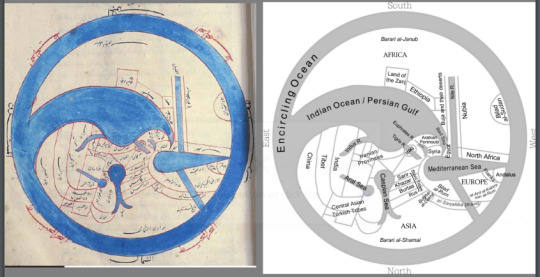
Map of the world from al-Istakhri, Kitab al-Masalik wa-al-Mamalik (Book of Roads and Kingdoms), 1470s, Istanbul, Sülemaniye Camii Kütüphanesi, Aya Sofya 2971a, f3a.
Another thing art reveals, apart from location and trade, it can also reveal religion and it’s spreading into other cultures. For example, this artwork has no real background or noted background, much of its history is lost and so we can only speculate. This artwork is believed to be from Kosovo, and given the rich history there, especially with the Ottomans, we can only guess at what it’s depicting: one such answer (and favoured) is a Christian institution in the Ottoman empire. We know it’s from around the 15th century and contains inscriptions. We also see Bells in the artwork, which is most associated with churches as opposed to other religious houses, and the interior of the building is covered with wall paintings perhaps of Mary or Jesus on the donkey. And the head coverings are non-Islamic.
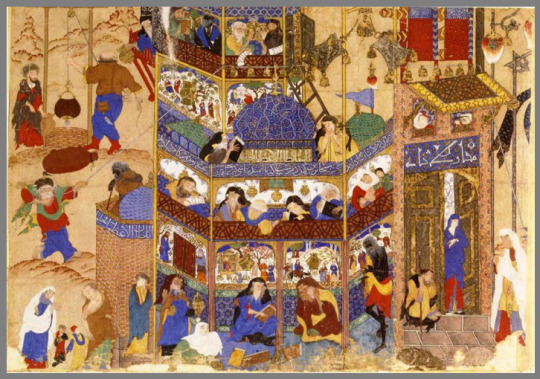
Monastery Scene, Iran, fifteenth century, opaque pigment, ink and gold on paper, 34 x 48cm, Topkapı Sarayı Müzesi, Istanbul, H.2153, f.131b
While we have little context, this artwork was found stuck into another book, like a scrapbook. This lack of context means we must refer to cultural background to make the history. We do know that Persian art draws on many artistic backgrounds.
This next painting comes from Spain, Barcelona. A large-scale painting, part of many other paintings in a giant altarpiece, or rather put behind the alter. While looking straight on from a photo doesn’t do this painting justice for its scale and gold detailing, and it’s low relief like sculpture aspect to it.

Reconstruction of the St Augustine Retable for the church of St Augustine, Barcelona, commissioned from Jaume Huguet 1463
This painting has colonial history to it, while our lecturer realised it predated the slave trade and Spain plundering of America (1492), it did not predate Spain and Portugal’s plundering of Africa. Economic history factors into current art and art ownership. Note: Europe imports many luxury items and good, apaying with vast amounts of gold as it doesn’t have luxury goods to send back. So where does the gold come from when it’s predating the America’s. Africa of course, pillaging the caravans filled with Gold that travelled across the Sahara and other places.
Now keeping this knowledge in mind, turn your attention to the painting, and a secondary photo from a visit in person, notice all the gold low reliefs.
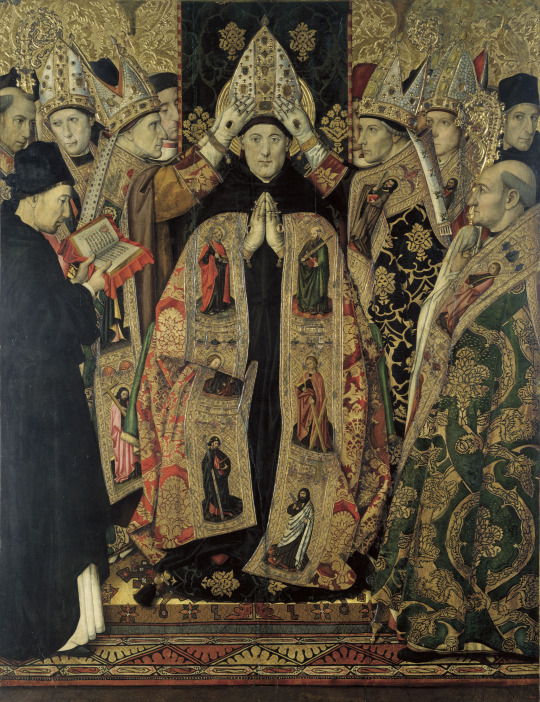

Jaume Huguet, The Consecration of Saint Augustine, between 1463 and 1486, tempera on panel, 250 x 193 cm, Museu Nacional d'Art de Catalunya, Barcelona

The Catalan Atlas, c. 1375, Bibliothèque Nationale, Paris
Once more cartography books boost Art History, showing world views of the historical world and in art. While this Atlas has a great many details, I would like to highlight a specific part, which relates to the aforementioned painting from Spain. When in the 15th century Portugal and then Spain navigated North Africa.

'This black Lord is called Musse Melly and is the sovereign of the land of the black people of Gineva (Ghana). This king is the richest and noblest of all these lands due to the abundance of gold that is extracted from his lands.’
Musse Melly is where the gold comes from, and this man was a real Lord. There are records of his travels across Africa to Egypt, and giving away do much gold in Egypt it ruined the economy for many years.

PART 2 OF POST: BENIN ‘BRONZES’
#Youtube#art show#art gallery#art hitory#artists on tumblr#architecture#art#artwork#history#histoire#writing#art tag#essay#paintings#art exhibition#essay writing#artists#writers#art history#writeblr#history lesson#historical#life lessons#lecture#learn#academic writing#on writing#writer#world building#world
17 notes
·
View notes
Photo
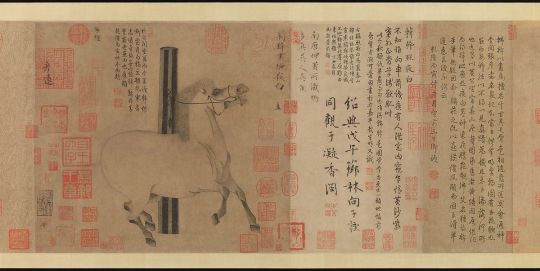

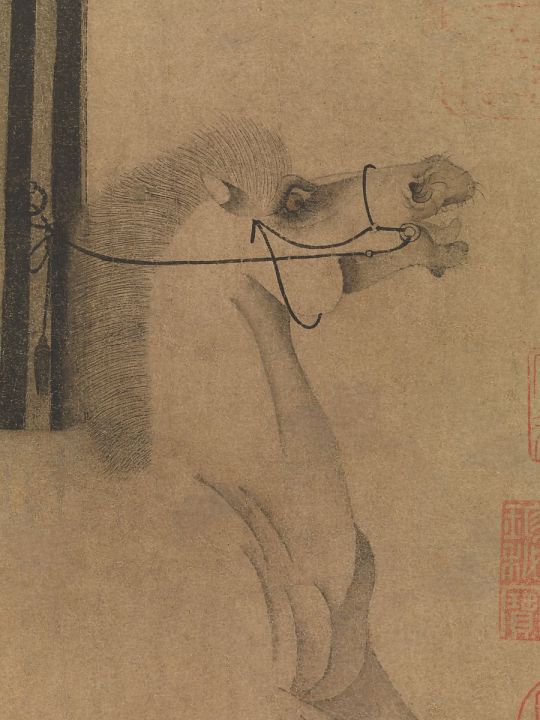
Han Gan (Chinese, active ca. 742–756), Night-Shining White, ca. 750, Tang dynasty (618–907), handscroll, ink on paper, 30.8 x 34 cm, The Metropolitan Museum of Art.
“A leading horse painter of the Tang dynasty, Han Gan was known for capturing not only the likeness of a horse but also its spirit. This painting, the most famous work attributed to the artist, is a portrait of a charger of Emperor Xuanzong (r. 712–56). With its burning eye, flaring nostrils, and dancing hoofs, the fiery-tempered horse epitomizes Chinese myths about Central Asian “celestial steeds” that “sweated blood” and were actually dragons in disguise. The seals and inscriptions added to the painting and its borders by later owners and appreciators are a distinctive feature of Chinese collecting and connoisseurship. The addition of more than one thousand years of seals and comments offers a vivid testimony of the work's transmission and its impact on later generations.
The acquisition of this image, arguably the greatest equine portrait in Chinese painting, marked the Director’s early commitment to revitalizing the Department of Asian Art under the curatorial leadership of Wen Fong and with the dedicated support of trustee Douglas Dillon.”
86 notes
·
View notes
Photo

Chinese Watercolour On Silk Flowers Bird Painting - Jiang Tingxi https://www.etsy.com/listing/1370499671/a7504-chinese-watercolour-on-silk?click_key=ded76dfe0313c130383c48eff17b2b88ec38f925%3A1370499671&click_sum=77df79c9&ref=shop_home_active_13&frs=1
0 notes
Text


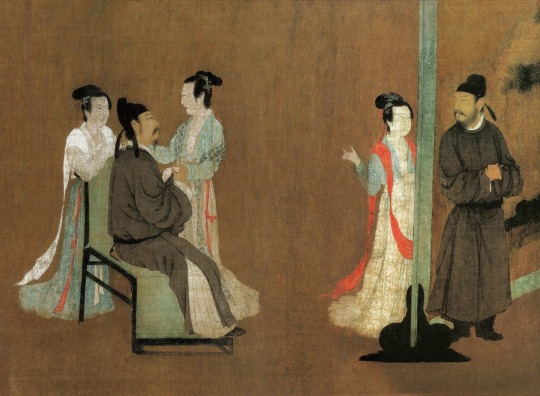

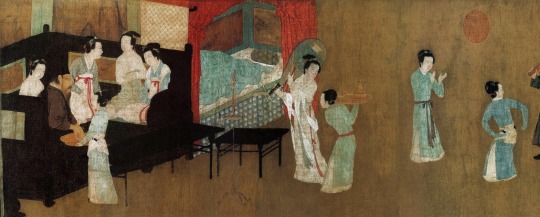

Night Revels of Han Xizai, handscroll, 12th century, Song dynasty painting after an original by Gu Hongzhong (10th century)
101 notes
·
View notes